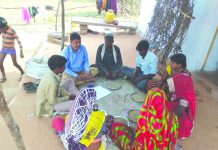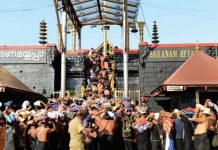Kashmir: 20 Years Later
Normalcy is a dangerous smokescreen. Beneath it, the valley is in the grip 0f a psychological siege. It needs political balm, not military might, says Harinder Baweja. Photographs by Abid Bhat

SOON, DECEMBER 8, 2009, will be a date in the past — another reminder of Kashmir’s long history of violence. For the record, it marks 20 years of insurgency. It was on this day, two decades ago, that Rubaiya Sayeed — daughter of the then home minister Mufti Mohammad Sayeed – was kidnapped. It was also the day when tens of thousands of ordinary Kashmiris took to the streets, shouting azadi. A day when the youth openly brandished their Kalashnikovs and mothers took pride in putting mehendi (henna) on their sons’ hands, kissing them on their foreheads and sending them paar (across the border into Pakistan) for training.
Twenty years ago, young Kashmiri boys were garlanded and feted when they returned as trained warriors; warriors who everyone thought would help ‘liberate’ them from India, then seen only as a brutal occupational force. In those heady, romantic days, Jawaharlal Nehru’s unkept promise of a plebiscite took centrestage and the Valley began its long tryst with violence; mass-backed violence that took the state government headed by Farooq Abdullah and the Central government by VP Singh by total surprise.
But this piece is not about the past. It is about the present. It is about the deep psychological siege that envelopes the Valley like a shroud. Death, destruction, unending periods of curfew and hartals have transformed what was once jannat into a place that now boasts of a vocabulary unknown to other parts of the country. The administration and the large security apparatus describe it variously as having “surface normalcy” and a conflict zone that has been “contained”.
On the surface – 20 years later – Srinagar can well pass off for any other city. Fortified bunkers still dot the landscape and armed jawans, their fingers always on the trigger, are a common sight. But the state capital appears to have fought its way out of its cold and bare look. A new visitor or a first-time tourist can well be taken in by the traffic snarls, the stark beauty of multi-coloured chinar leaves that are so a part of Kashmir’s early winter and the busy look that the boulevard facing the weed-laden Dal lake wears – but it all fits into the ‘containment’ that the babus in North Block pat themselves for.
Scratch the surface and, for a moment, forget the images of the saffron fields, the majestic mountains that ring the Dal lake, the early snowfall over Gulmarg’s meadow, and a whole new reality will stare you in the face. Try and make sense of this reality and you will see what 20 years of violence have done to an entire population of five million. Every family in this large conflict zone is an example of collateral damage. Every member carries scars of being an endless prisoner of war. Everyone’s speech is littered with words like mujahid, bandook (gun), graves, yateem (orphan) and bloodshed.
On the surface, Srinagar can pass off for any other city. But this fits into the ‘containment’ policy that North Block babus now pat themselves for
The words come easy. They are a part of the local vocabulary. Meet young Ashfaq Mir. He is only 11 years old and now lives in Raahat Manzil, an orphanage on the outskirts of Srinagar. Most part of his day is now spent in the company of 460 boys — all orphans of violence; all bound by a common sense of fear and grief. And listen to Ashfaq talk: “They came through the forest holding Kalashnikovs. They stood in the street near our home and asked my father for directions. Abbu didn’t want to go with them but they forced him. You can’t argue with them, not when they are wielding Kalashnikovs. There is an army camp around our house because it is not far from the border with Pakistan. The mujahideen were not scared that an army camp was nearby.Mujahideen ne fire mara (the militants opened fire) and killed my abbu. I don’t know why he was killed but others near my house said he was killed because the mujahid said he was a mukhbir (informer). My mother goes to his grave and cries. She has now started teaching drawing. She comes here sometimes to meet me and says I am better off here because she also has a sister and brother to look after. I get free education and food here. The day passes easily but at night I feel scared and have bad dreams. A djinn kills a man and I can see blood all over this man. I have spoken to a doctor and he has given me some medicines but the dream persists…”

Notice the choice of words. It is not just that the vocabulary of young Ashfaq is striking or that it is littered with words like guns, firing, crackdown, death and graves. It is the ease, the matter-of-fact manner in which these words are delivered that is stunning. Ashfaq was only seven when his father was killed. He hails from Karna in Tangdhar, a 90-minute drive from Srinagar, but he could have been from anywhere in the Valley. From a remote village in Kupwara, four hours from Srinagar, or from Anantnag, 50 km from the state capital. There is no town or village in Kashmir that hasn’t been touched by violence; no child whose young mind has not been scarred.
Ashfaq is not the only midnight’s child. Nor the only one who has dropped out of childhood and grown up in quick time, mostly to personal brushes with violence and its consequences. Shakib Dar, a friend of Ashfaq’s, speaks in a language that breaks your heart. He is only six and when asked about his father, he says, “They have kept a big stone, a very big stone slab on top of my father so he can’t come home from the Idgah. I keep telling my mother to remove that slab but she doesn’t listen. She just cries.” His mother lives in one of Srinagar’s downtown localities, which was home to scores of Kashmiri Pandit families. When Ashfaq goes to visit his mother, he plays in the ruins of homes that once belonged to these Pandit families, but he is unaware about the original occupants of these homes. Once it was impossible to think of a Kashmir without Pandits. Today, it is difficult to find one there.












